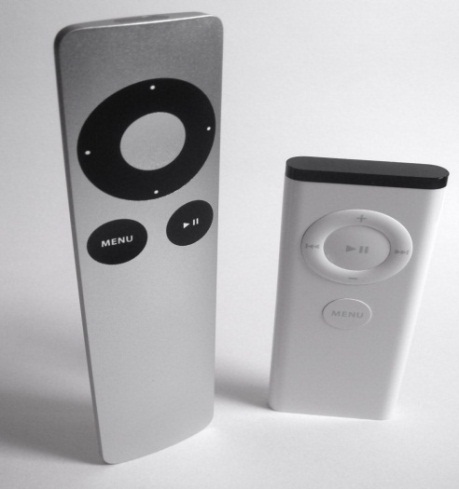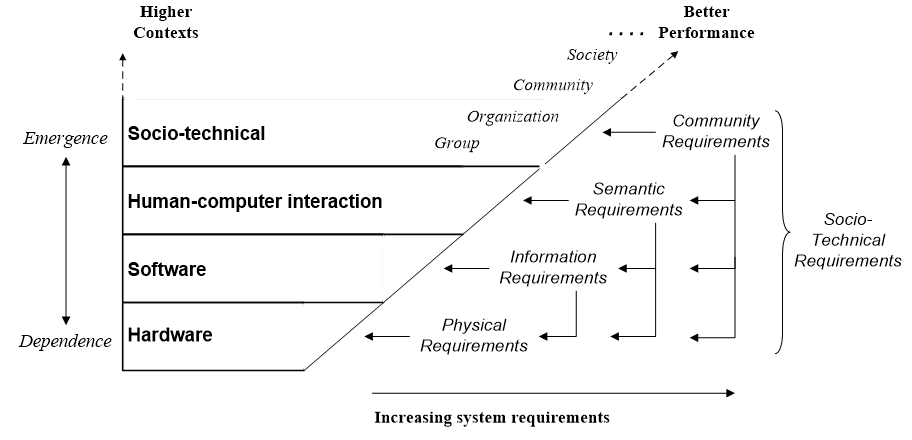
The idea of computing levels makes system design complex, as the design requirements of a higher level “flow down” to affect levels below it. This gives us a variety of design fields, as follows.
1. Ergonomics designs safe and comfortable machines for people. Applying biological needs, such as avoiding posture and eye-strain, to technology design merges biology and engineering.
2. Object design applies psychological needs to technology in the same way (Norman, 1990): e.g. a door’s design affects whether it is pushed or pulled. An affordance is a physical object feature that cues its human use, as buttons cue pressing. Physical systems designed with affordances based on human requirements perform better. In World War II, aircraft crashed until engineers designed cockpit controls with the cognitive needs of pilots in mind, as follows (with computing examples):

• Put the control by the thing controlled, e.g. a handle on a door (context menus).
• Let the control “cue” the required action, e.g. a joystick (a 3D screen button).
• Make the action/result link intuitive, e.g. press a joystick forward to go down, (press a button down to turn on).
• Provide continuous feedback, e.g. an altimeter, (a web site breadcrumbs line).
• Reduce mode channels, e.g. altimeter readings, (avoid edit and zoom mode confusions).
• Use alternate sensory channels, e.g. warning sounds, (error beeps).
• Let pilots “play”, e.g. flight simulators, (a system sandbox).
3. Human computer interaction applies psychology requirements to screen design. Usable interfaces respect cognitive needs, e.g. by the nature of human attention, users do not usually read the entire screen. HCI turns psychological needs into IT designs as architecture turns buyer needs into house designs. Compare Steve Jobs’ IPod to a television remote (Figure 1.8). Both are controls, but one is a cool tool and the other a mass of buttons. If one was designed to engineering requirements and the other to HCI requirements, which performs better?
4. Fashion is based on the social need to look good applied to wearable object design. In computing, a mobile phone can be a fashion accessory, just like a hat or handbag. Its role is to impress, not just to function. Aesthetic criteria apply when people buy mobile phones to be trendy or fashionable, so color can be as important as battery life in mobile phone design.
5. Socio-technology is information technology that meets social requirements. Anyone online can see its power, but most academics see it as an aspect of their specialty, rather than a new multi-discipline in its own right. As computing evolved a social level, social requirements became part of computing design (Sanders & McCormick, 1993).
Multi-disciplinary fields cannot, by their nature, be reduced to component discipline specialties; e.g. sociologists study society not technology, and technologists study technology not society, so neither can address socio-technical design — how social needs impact technical design. Table 1.3 summarizes design fields by level combination.
|
Design |
Requirements |
Target |
Examples |
|
STS |
Social |
IT |
Wikipedia, YouTube, E-bay |
|
Fashion |
Social |
Physical Accessory |
Mobile phone as an accessory |
|
HCI |
Psychological |
IT |
Framing, border contrast, richness |
|
Design |
Psychological |
Technology |
Keyboard, mouse |
|
Ergonomics |
Biological |
Technology |
Adjustable height screen |
Table 1.3: Design fields by target and requirement levels

In Figure 1.9, higher level requirements flow down to lower level design, giving a higher affects lower design principle. Higher levels direct lower ones how to improve system performance, as the requirements of each level flow down to those below, e.g. communities that create normative influence at the citizen level, create laws at the informational level, and cultural events at the physical level. The same applies online, as online communities make demands of Netizens as well as software. STS design therefore is about having it all: reliable devices, efficient code, intuitive interfaces and sustainable communities. Ultimately social requirements such as privacy and freedom will affect interface design, how software is written and even how hardware is built.
Note that the social level is open ended, as social groups form higher social groups, e.g. in physical society, over thousands of years, families formed tribes, tribes formed city states, city-states formed nations and nations formed nations of nations, each with more complex social structures (Diamond, 1998). How social units combine into higher social units with new requirements is discussed further in Chapter 5, where the social unit of analysis can be a person, a friend dyad, a group, a tribe, etc.
So it is naive to think that friend systems like Facebook are the last step, that social computing will stop at a social unit size of two. Beyond friends are tribes, cities, city-states, nations and meta-nations like the USA. Since we have a friend but belong to a community, the rules also change. With the world population at seven billion and growing, Facebook’s over a billion active accounts are just the beginning. The future is computer support not just for friends, but also for families, tribes, nations and even global humanity.
For example, imagine a group browser, designed for many not just one, so that people can browse the Internet in groups, discussing as they go. Instead of a physical tour bus we will have an informational tour “bus”. It can have a “driver” who comments along the way: “This site shows how the Internet began …”. Or members could take turns to host the next site, showing what they like. The possibilities of social computing are just beginning.